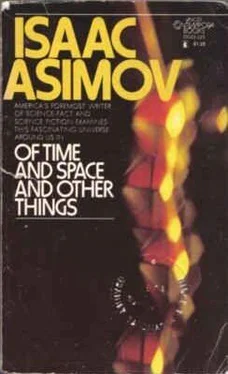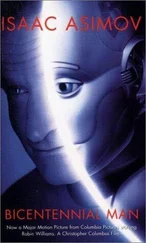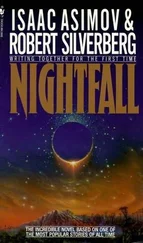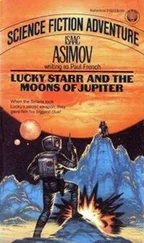Isaac Asimov - Of Time and Space and Other Things
Здесь есть возможность читать онлайн «Isaac Asimov - Of Time and Space and Other Things» весь текст электронной книги совершенно бесплатно (целиком полную версию без сокращений). В некоторых случаях можно слушать аудио, скачать через торрент в формате fb2 и присутствует краткое содержание. Год выпуска: 1972, ISBN: 1972, Издательство: Lancer Books, Жанр: Прочая научная литература, на английском языке. Описание произведения, (предисловие) а так же отзывы посетителей доступны на портале библиотеки ЛибКат.
- Название:Of Time and Space and Other Things
- Автор:
- Издательство:Lancer Books
- Жанр:
- Год:1972
- ISBN:ISBN: 0-447-33023-3
- Рейтинг книги:4 / 5. Голосов: 1
-
Избранное:Добавить в избранное
- Отзывы:
-
Ваша оценка:
- 80
- 1
- 2
- 3
- 4
- 5
Of Time and Space and Other Things: краткое содержание, описание и аннотация
Предлагаем к чтению аннотацию, описание, краткое содержание или предисловие (зависит от того, что написал сам автор книги «Of Time and Space and Other Things»). Если вы не нашли необходимую информацию о книге — напишите в комментариях, мы постараемся отыскать её.
Of Time and Space and Other Things — читать онлайн бесплатно полную книгу (весь текст) целиком
Ниже представлен текст книги, разбитый по страницам. Система сохранения места последней прочитанной страницы, позволяет с удобством читать онлайн бесплатно книгу «Of Time and Space and Other Things», без необходимости каждый раз заново искать на чём Вы остановились. Поставьте закладку, и сможете в любой момент перейти на страницу, на которой закончили чтение.
Интервал:
Закладка:
Wouldn't you know?
Before 1740, sulfuric acid was hard to prepare. In the* That's all right, though. Sulfuric acid may not be as costly as gold, but it is conservatively speaking-a trillion times as in trinsically useful.
ory, it was easy. You bum sulfur, combining it with oxygen to form sulfur dioxide (SO2)- You burn sulfur dioxide further to make sulfur trioxide (SO3)- You dissolve sulfur trioxide in water to make sulfuric acid, (H2SO4) - The trick, though, was to make sulfur dioxide combine with oxygen.
That could only be done slowly and with difficulty.
In the 1740s, however, an English sulfuric acid man ufacturer named Joshua Ward must have reasoned that saltpeter (potassium nitrate), though nonflammable itself, caused carbon and sulfur to burn with great avidity. (In fact, carbon plus sulfur plus saltpeter is gunpower.) Con sequently, he added saltpeter to his burning sulfur and found that he now obtained sulfur tri'oxide without much trouble and could make sulfuric acid easily and cheaply.
The most wonderful thing about the process was that, at the end, the saltpeter was still present, unchanged. It could be used over and over again. Ward patented the process and the price of sulfuric acid dropped to 5 per cent of what it was before.
Magic? - Well, no.
In 1806, two French chemists, Charles Bernard Ddsormes and Nicholas C16ment, advanced an explanation that contained a principle which is accepted to this day.
It seems, you see, that when sulfur and saltpeter bum together, sulfur dioxide combines with a portion of the saltpeter molecule to form a complex. The oxygen of the saltpeter portion of the complex transfers to the sulfur dioxide portion, which now breaks away as sulfur tri oxide.
What's left (the saltpeter fragment minus oxygen) pro ceeds to pick up that missing oxygen, very readily, from the atmosphere. The saltpeter fragment, restored again, is ready to combine with an additional molecule of sulfur dioxide and pass along oxygen. It is the saltpeter's task simply to pass oxygen from air to sulfur dioxide as fast as it can. It is a middleman, and of course it remains un changed at the end of the reaction.
In fact, the wonder is not that a catalyst hastens a re action while remaining apparently unchanged, but that anyone should suspect even for a moment that anything "magical" is involved. If we were to come across the same phenomenon in the more ordinary affairs of life, we would certainly not make that mistake of assuming magic.
For instance, consider a half-finished brick wall and, five feet from it, a heap of bricks and some mortar. If that were all, then you would expect no change in the situation between 9 A.m. and 5 P.m. except that the mortar would dry out.
Suppose, however, that at 9 A.M. you observed one fac tor in addition-a man, in overalls, standing quietly be tween the wall and the heap of bricks with his hands empty. You observed matters again at 5 P.m. and the same man is standing there, his hands still empty. He has not changed. However, the brick wall is now completed and' the heap of bricks is gone.
The man clearly fulfills the role of catalyst. A reaction has taken place as a result, apparently, of his mere pres ence and without any visible change of diminution in him.
Yet would we dream for a moment of saying "Magic!"?
We would, instead, take it for granted that had we ob served the man in detail all day, we would have caught him transferring the bricks from the heap to the wall one at a time. And what's not magic for the bricklayer is not magic for the saltpeter, either.
With the birth and progress of the nineteenth century, more examples of this sort of thing were discovered. In 1812, for instance, the Russian chemist Gottlieb Sigis mund Kirchhoff…
And here I break off and begin a longish digression for no other reason than that I want to; relying, as I always do, on the infinite patience and good humor of the Gentle Readers.
It may strike you that in saying "the Russian chemist, Gottlieb Sig7ismund Kirchhoff" I have made a humorous error. Surely no one with a name like Gottlieb Sigismund Kirchhoff can be a Russian! It depends, however, on whether you mean a Russian in an ethnic or in a geographic sense.
To explain what I mean, let's go back to the beginning of the thirteenth century. At that time, the regions of our land and Livonia, along the southeastern shores of the Baltic Sea (the modem Latvia and Estonia) were in habited by virtually the last group of pagans in Europe. It was the time of the Crusades, and the Germans to the southeast felt it a pious duty to slaughter the poorly armed and disorganized pagans for the sake of their souls.
The crusading Germans were of the "Order of the Knights of the Sword" (better known by the shorter and more popular name of "Livonian Knights"). They were joined in 1237 by the Teutonic Knights, who had first established themselves in the Holy Land. By the end of the thirteenth century the Baltic shores had been conquered, with the German expeditionary forces in control.
The Teutonic Knights, as a political organization, did not maintain control for more than a couple of centuries.
They were defeated by the Poles in the 1460s. The Swedes, under Gustavus Adolphus, took over in the 1620s, and in the 1720s the Russians, under Peter the Great, replaced the Swedes.
Nevertheless, however the political tides might shift and whatever flag flew and to whatever monarch the loyal in habitants might drink toasts, the land itself continued to belong to the "Baltic barons" (or "Balts") who were the German-speaking descendants of the Teutonic Knights.
Peter the Great was an aggressive Westernizer who built a new capital, St. Petersburg* at the very edge of the Livonian area, and the Balts were a valued group of sub jects indeed.
This remained true all through the eighteenth and nine teenth centuries when the Balts possessed an influence within the Russian Empire out of all proportion to their numbers. Their influence in Russian science was even more lopsided.
The trouble was that public education within Russia lagged far behind its status in western Europe. The Tsars saw no reason to encourage public education and make trouble for themselves. No doubt they felt instinctively that The city was named for his name-saint and not for himself.
Whatever Tsar Peter was, a saint he was not a corrupt and stupid government is only really safe with an uneducated populace.
This meant that even elite Russians who wanted a secular education had to go abroad, especially if they wanted a graduate education in science. Going abroad was not easy, either, for it meant leaming a new language and new ways. What's more, the Russian Orthodox Church viewed all Westerners as heretics and little better than heathens. Contact with heathen ways (such as science) was at best dangerous and at worst damnation. Consequently, for a Russian to travel West for an education meant the overcoming of religious scruples as well.
The Balts, however, were German in culture and Lu theran in religion and had none of these inhibitions. They shared, with the Germans of Germany itself, in the,height ening level of education-in particular, of scientific educa tion-through the eighteenth and nineteenth centuries.
So it follows that among the great Russian scientists of the nineteenth century we not only have a man with a name like Gottlieb Sigismund Kirchhoff, but also others with names like Friedrich Konrad Beilstein, Karl Ernst von Baer, and Wilhelm Ostwald.
This is not to say that there weren't Russian scientists in this period with Russian names. Examples are Mikhail Vasilievich Lomonosov, Aleksandr Onufrievich Kovalev ski, and Dmitri Ivanovich Mendel6ev.
However, Russian officialdom actually preferred the Balts (who supported the Tsarist government under which they flourished) to the Russian intelligentsia itself (which frequently made trouble and had vague notions of reform).
Читать дальшеИнтервал:
Закладка:
Похожие книги на «Of Time and Space and Other Things»
Представляем Вашему вниманию похожие книги на «Of Time and Space and Other Things» списком для выбора. Мы отобрали схожую по названию и смыслу литературу в надежде предоставить читателям больше вариантов отыскать новые, интересные, ещё непрочитанные произведения.
Обсуждение, отзывы о книге «Of Time and Space and Other Things» и просто собственные мнения читателей. Оставьте ваши комментарии, напишите, что Вы думаете о произведении, его смысле или главных героях. Укажите что конкретно понравилось, а что нет, и почему Вы так считаете.












